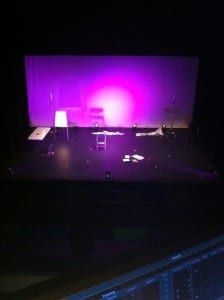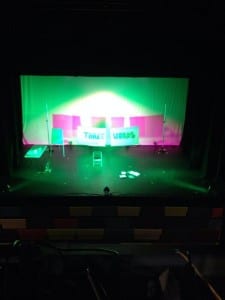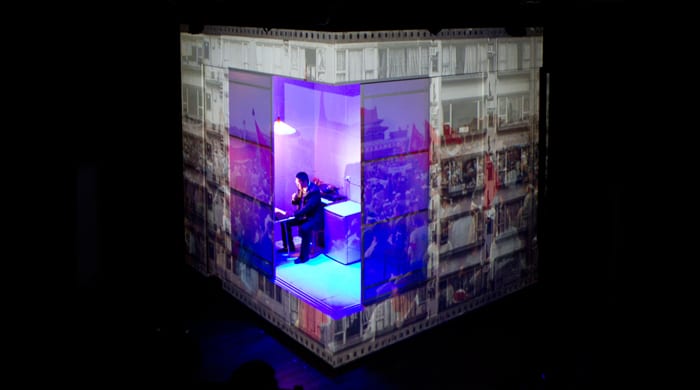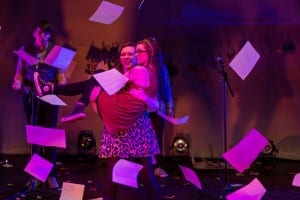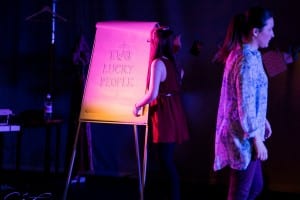
Taking our caption ‘Two Lucky People’ from one of our scenes, we found that there were not two, but in fact nine lucky people in our company. Every single member, including myself, could not feel any more fortunate to be able to create and perform Three Words. Throughout our devising process we were never alone; we worked closely as a team and collaborated with our ideas. From a Production Manager’s point of view I certainly could not have technically done this show without my Stage Manager (Shellie Barrowcliffe), she was my rock throughout this production. While regularly meeting up for production meetings, together we created the lighting for Three Words and made sure any technical requirements were secured for rehearsals and finally for our show. I trust that together we made a fantastic team and I hope to work closely with her again at some point in our careers.
For our actual performance day, 27th May 2014, we arranged for the whole cast and crew to enter the Lincoln Performing Arts Centre theatre at 9am. Normally we would not call the cast till around 12pm, but even though our technical rehearsal went smoothly we realised that figuring out sound levels would take longer than we expected. Therefore we had to make sure all the cast were available from the beginning of our Get In so that our LPAC technician Martin could start checking all of the microphone levels for actors and musicians for every scene in show. The entire cast was very patient throughout our Get In, they listened carefully whether it was to speak into a microphone, stand in a certain light, or set up the stage with props. They were all completely focused and did not wander off, consequently it created a calm atmosphere for us all to work in efficiently. Our cue-to-cue was mainly for my SM and any other technicians operating the show to double check the lighting and sound was prepared for each cue in the prompt book. From this, we went onto our dress rehearsal. We made sure every cast member was aware that it must be as high energy as our final performance that evening, and fortunately they were all incredibly professional and we left our dress fun feeling like we had a show ready, professional standard, to show our audience. It left us all pleased and in high spirits for the final performance.
For our Get Out, my fantastic SM had prepared a detailed schedule for each person to follow, in order for us to clear everything away and leave the premises in good time. Again, each cast and crew member were completely focused in the tasks they had been given and followed them carefully. And considering how many cables we had lying around the stage with all the microphones and lights, we were able to tidy everything away and put them back in their original places if they belonged to the LPAC. Below are links to both the Performance day and Get Out schedules that my SM prepared:
Three Words Performance Day Schedule
My final words for this performance are excitement, hope and potential. I believe No Added Sugar, and Three Words itself has a future. The feedback we have received from this production has been incredible and I could not be prouder to call myself a member of this team. I start to feel emotional at looking through any photos from past rehearsals, or even the ones from the actual performance, I have had the time of my life doing Three Words. I seriously hope this production, and company, live on. The future is bright, and we have potentially already been offered an opportunity to perform Three Words once more. Who knows, you may even find us at Edinbrough Fringe Festival next year. Keep your eyes peeled!
Works Cited
Abigail Dawson (2013) Reflection of our Final Degree Performance [Online Video] Available from https://www.youtube.com/watch?v=Mint9L2x7M0 [Accessed 1 June 2014]
